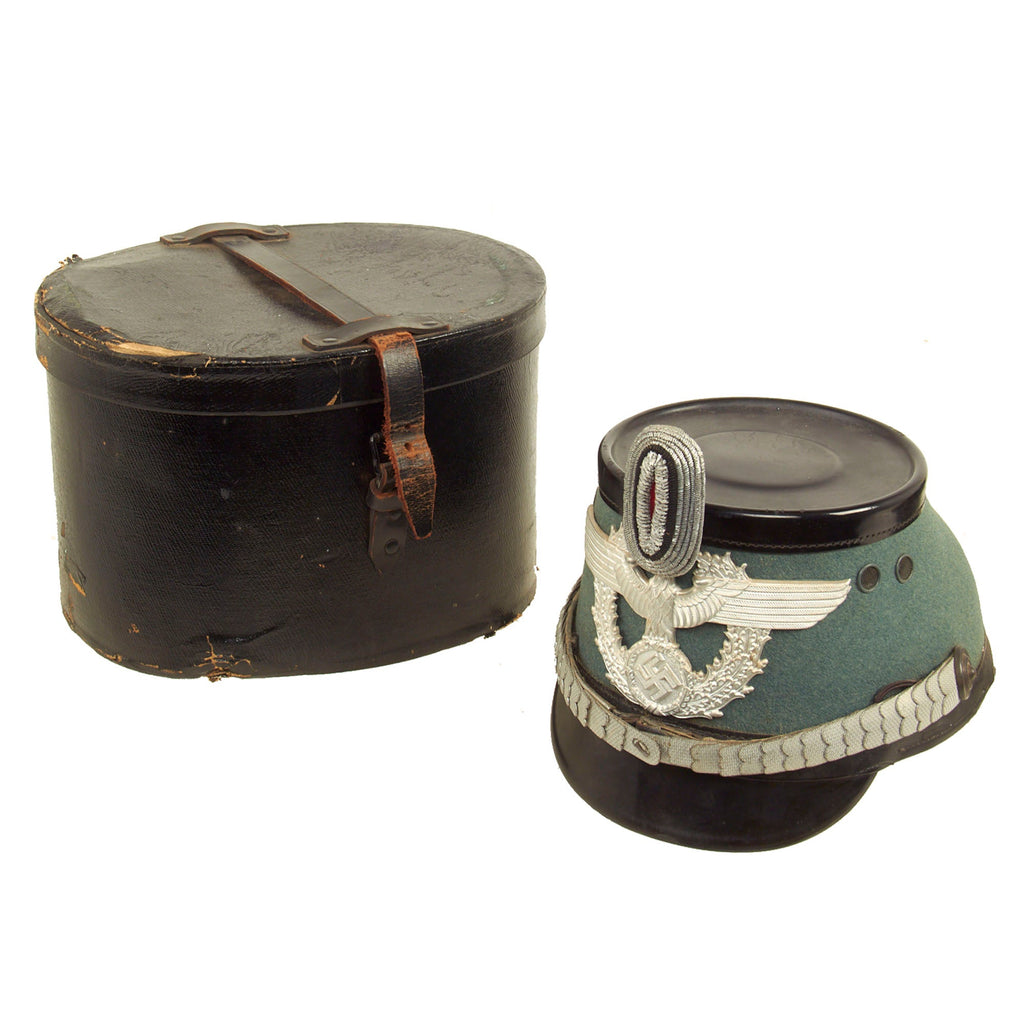Item Description
Original Item: Only One Available. This is a fantastic high grade Metropolitan Police 1936 Officers Pattern Tschako, complete with a very rare original leatherette covered cardboard case! It is of the later pattern, with a police blue green wool body and black leather trim. It has a very fine quality police officer aluminum eagle front plate, with high grade silvered aluminum chin scales, something we rarely see. From what we can tell these were only worn by high ranking officers, and this is only the second example we have had with this type of chin strap. The front top of the helmet has a wonderful high end aluminum bullion Feldzeichen cockade (often missing), which can be removed for storage in the case. A great Polizei helmet (shako) as used by the police in the metropolitan of Germany! Unlike some of the more common ones found trimmed in brown for rural police, this one is with black trim for the municipal police.
Interior is excellent, and this "private purchase" example has a leather liner with an olive brown colored skullcap, very much like officer pickelhaube helmets from the first world war era and before. The leather is supple and shows only light age and is completely unmarked, but seems to be around a size 56 / 7 US. The skull cap has a lovely color, and the wire supports are fully intact. Vents are in perfect condition, and are the type without any sliding closure. There was originally orange red foam rubber padding going around the interior under the sweatband, however it has completely deteriorated and crumbled, as that specific type virtually always does.
There is not any maker marking that we can find on the interior of the helmet, so it is most likely a bespoke example. In fantastic condition, this is definitely a great collector's opportunity that will not be repeated anytime soon. The included carry case is also in very good condition, with an intact leather carry / closure strap, and measures approximately 10 1/2" x 9" x 7"H.
A fantastic German WWII Police Tschako offering, ready to display!
History of the shako-
The word shako originated from the Hungarian name csákós süveg ("peaked cap"), which was a part of the uniform of the Hungarian hussar of the 18th century. Other spellings include chako, czako, schako and tschako.
From 1800 on the shako became a common military headdress, worn by the majority of regiments in the armies of Europe and the Americas. Replacing in most instances the light bicorne, the shako was initially considered an improvement. Made of heavy felt and leather, it retained its shape and provided some protection for the soldier's skull, while its visor shaded his eyes. The shako retained this pre-eminence until the mid-19th century, when spiked helmets began to appear in the armies of the various German States, and the more practical kepi replaced it for all but parade wear in the French Army. The Imperial Russian Army substituted a spiked helmet for the shako in 1844-45 but returned to the latter headdress in 1855, before adopting a form of kepi in 1864. Following the Franco-Prussian War of 1870, military fashions changed and cloth or leather helmets based on the German headdress began to supersede the shako in many armies.
Although the mid-nineteenth century shako was impressive in appearance and added to the height of the wearer, it was also heavy and by itself provided little protection against bad weather as most models were made of cloth or felt material over a leather body and peak. Many armies countered this by utilizing specially designed oilskin covers to protect the shako and the wearer from heavy rain while on campaign. The shako provided little protection from enemy action as the most it could offer was in giving partial shielding of the skull from enemy cavalry sabers.
- This product is available for international shipping. Shipping not available to: Australia, France, or Germany
- Not eligible for payment with Paypal or Amazon















